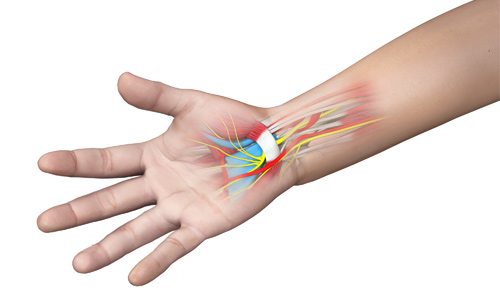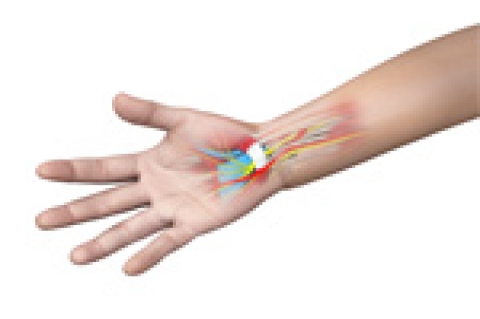
The carpal tunnel is a narrow passage composed of ligament and bones at the base of the hand. It contains the median nerve and tendons that provide flexibility to the fingers. The median nerve provides sensation to the thumb, index, middle, and part of the ring fingers, and controls some muscles at the base of the thumb.
Carpal tunnel syndrome (CTS) is an entrapment neuropathy in which one of the peripheral nerves is impacted. Inflamed, swollen, or irritated tendons narrow the tunnel and compress the nerve at the wrist. This results in numbness, weakness, or pain in the hand, wrist, forearm, or arm.
These sensations are also symptoms of other neuropathic disorders and hence diagnosis can become confusing.
Causes of Carpal Tunnel Syndrome
Carpal tunnel syndrome entraps the median nerve and is the result of a combination of factors that cause the tunnel to contract. It is not a problem with the nerve itself.
Trauma or injury to the wrist can cause swelling, sprain, or fractures. A glandular issue such as overactive pituitary gland or underactive thyroid gland could be a cause. Obesity and rheumatoid arthritis or disc herniation can also contribute to CTS.
Other causes include problems in the wrist joint, edema during pregnancy or menopause, or cysts or tumors in the canal.
Occupational stress and repetitive handling of vibrating hand tools can also contribute to the compression of the tunnel.
Symptoms of CTS
The onset of CTS symptoms is usually gradual and can include burning, tingling (pins and needles), itching, and numbness in the palm and fingers, which can move up to the elbow. Often patients complain of swollen, non-functioning fingers, even though swelling is not apparent.
These symptoms often start in one or both hands and are worse at night. On waking, stiffness in the hands and arms can decrease range of motion and create an urge to shake the hand or wrist vigorously.
These symptoms gradually manifest themselves during the day, too. Patients may experience decreased hand grip strength, leading to difficulty in fisting, grasping objects, or performing manual tasks. In some cases, sufferers cannot tell the difference between hot and cold objects by touch.
False Symptoms
Carpal tunnel syndrome is sometimes used as a generic label for any condition that causes pain, numbness, swelling, and burning in the hands and wrists. In fact, if pain is the primary symptom, CTS is probably not the cause.
Compression of the median nerve at the wrist causes CTS. However, there are other areas of compression that can cause similar symptoms in the hands and wrists and confusion in diagnosis. Elsewhere, these sensations are indicators of other issues.
- Thoracic outlet syndrome (TOS) is a compression of the artery or nerve bundle under the pectoralis minor muscle near the shoulder. This compression causes symptoms in the whole hand.
- Cubital tunnel syndrome, or ulnar nerve entrapment at the elbow, produces numbness and tingling in the little and ring fingers.
- Scalene syndrome, cervical disc herniations, and cervical radiculopathy can also cause abnormal or painful sensations, which usually begin in the neck and travel down the affected arm and hand. Symptoms may worsen with movement.
All have distinct causes and treatments, even though the symptoms mirror each other.
Diagnosis of Carpal Tunnel Syndrome
Accurate diagnosis of the condition is critical, as other nerve entrapment syndromes also produce symptoms noted in CTS. Early diagnosis and treatment are important to avoid permanent damage to the median nerve.
- Medical history and physical examination will determine if the symptoms are related to daily activities or an underlying disorder, and will rule out other conditions with similar symptoms.
- Laboratory tests and X-rays will reveal fractures, arthritis, and diseases that damage nerves.
- Tests like the Tinel and Phalen’s Maneuver reproduce the symptoms of CTS to help evaluate the condition.
- Electrodiagnostic tests like nerve conduction study and electromyography help confirm the diagnosis of CTS.
- Ultrasound imaging may show abnormalities in the median nerve, and magnetic resonance imaging (MRI) may reveal abnormal anatomy of the wrist.
Treatments for CTS
If CTS is diagnosed, treatment should be started immediately to prevent further progress of the condition.
- Underlying causes such as diabetes or arthritis should be addressed.
- Non-surgical treatments such as wearing splints or braces may be prescribed.
- Stopping or reducing relevant daytime activities, or breaking them up with periods of rest, may help.
- Over-the-counter NSAIDs (non-steroidal, anti-inflammatory drugs) can provide short-term pain relief.
- Prescription medicines such as corticosteroids or lidocaine can relieve pressure on the median nerve for mild or intermittent symptoms.
- Alternative therapies like yoga and soft tissue massage have been shown to reduce pain and improve grip strength. Some report relief from acupuncture and chiropractic.
If these measures fail, then carpal tunnel release surgery is an option.
Open release surgery, the traditional procedure, consists of making an incision up to 2 inches in the wrist and then cutting the carpal ligament to enlarge the carpal tunnel.
In endoscopic surgery the surgeon makes one or two incisions (about ½ inch each) in the wrist and palm; inserts a camera attached to a tube; observes the nerve, ligament, and tendons on a monitor; and cuts the carpal ligament with a small knife that is inserted through the tube.
Following surgery, the ligaments usually grow back together and allow more space than before.
If you feel you may have CTS, call South Palm Orthopedics at or request an appointment online.

